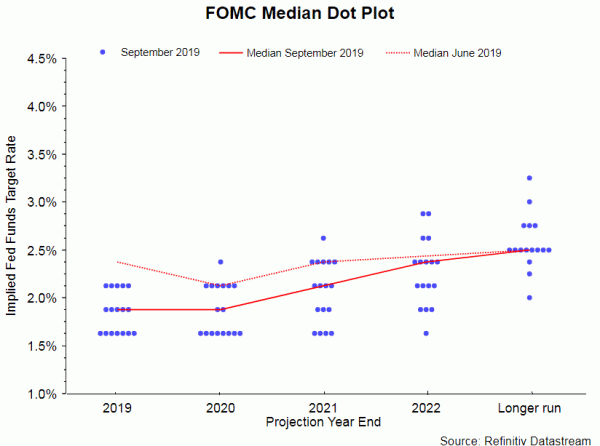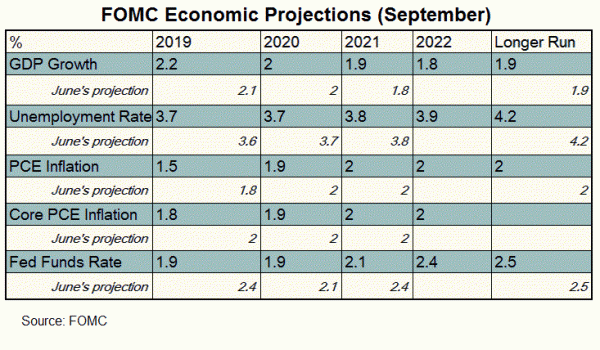Fed lowered the policy rate by -25 bps to 1.75-2.00%, although market expectations of a rate cut diminished markedly ahead of the meeting. The decision was not unanimous. Yet, it revealed a more divided Fed. The updated median dot plot shows a significant minority favoring one more cut by end-2019. As such, there remains chance for one more rate cut in the coming month. The market has priced in 28% chance of at least one more reduction by December. Meanwhile, the members expected no rate hike until 2021. The economic projections were little changed from June, although the members expressed greater concerns about the trade war uncertainty.
Three members dissented the rate decision. Boston Fed President Rosengren and Kansas City Fed President Esther George voted to maintain the policy rate unchanged. This has been expected as they did the same previously. The surprise came from St. Louis Fed President James Bullard who proposed a deeper cut of -50 bps. Reduction in the Fed funds rate was accompanied with cuts in excess reserves rate (IOER) and the rate on overnight repo facility (RPP), each by -5 bps.
Median Dot Plot: The median policy rate is 1.9% for both 2019 and 2020. It is then expected to rise to 2.1% and 2.4% in 2021 and 2022 respectively. While the median policy rate signals that there would be no change in the monetary policy, there were 7 out of 17 members favoring a third cut. This is a significant minority. We believe at least some of them were voting members. For 2020, 8 members favored lowering the policy rate to 1.5-1.75%, although the majority still opting to stay at where it is. The trend suggests that the chance of another rate cut this year remains.
Balance Sheet: As Powell indicated to “resume the organic growth of the balance sheet” earlier than previously anticipated. He added that the members would look at it “carefully in coming days and taking it up at the next meeting”. We expect the Fed would begin the process in the form of permanent open market operations in as soon as November.
Economic Developments: The assessment was largely the same as the July meeting. The members acknowledged that the labor market remains “strong” and economic activity has been rising at “a moderate rate”. There were some minor changes in the description of household spending and business investment. The Fed acknowledged that household spending has been “rising at a strong pace”. Yet, they added that “business fixed investment and exports have weakened”. In July, they noted that that growth of household spending “picked up from earlier in the year” while growth of business fixed investment remained “soft”. Reference to exports was obviously in light of escalations of trade war since the last meeting. In short, the Fed maintained that a “sustained expansion of economic activity, strong labor market conditions, and inflation near the Committee’s symmetric 2% objective are the most likely outcomes, but uncertainties about this outlook remain”.















